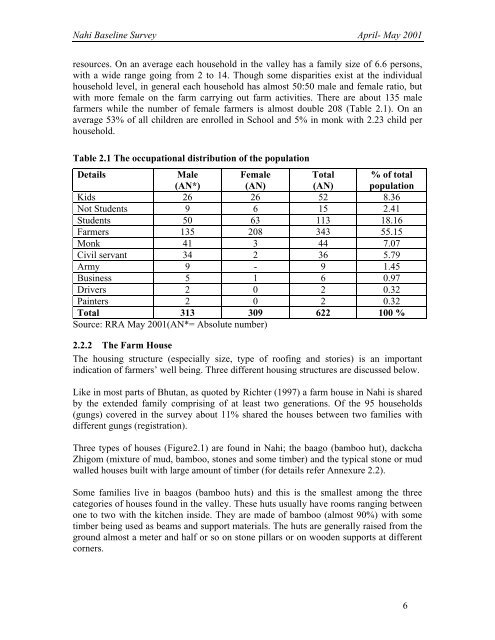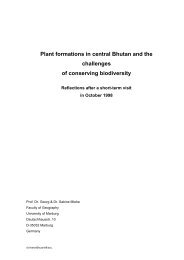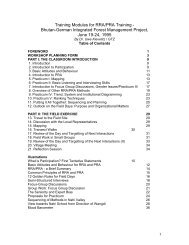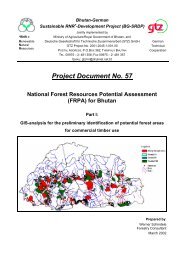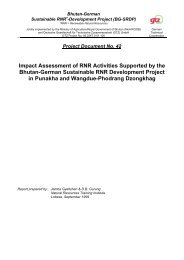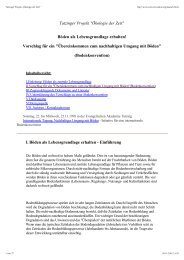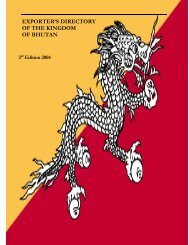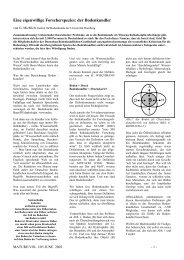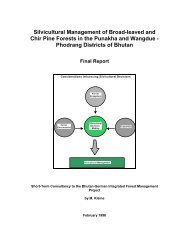GTZ Project Document No. 51 Report on Nahi Baseline Survey
GTZ Project Document No. 51 Report on Nahi Baseline Survey
GTZ Project Document No. 51 Report on Nahi Baseline Survey
Create successful ePaper yourself
Turn your PDF publications into a flip-book with our unique Google optimized e-Paper software.
<strong>Nahi</strong> <strong>Baseline</strong> <strong>Survey</strong> April- May 2001resources. On an average each household in the valley has a family size of 6.6 pers<strong>on</strong>s,with a wide range going from 2 to 14. Though some disparities exist at the individualhousehold level, in general each household has almost 50:50 male and female ratio, butwith more female <strong>on</strong> the farm carrying out farm activities. There are about 135 malefarmers while the number of female farmers is almost double 208 (Table 2.1). On anaverage 53% of all children are enrolled in School and 5% in m<strong>on</strong>k with 2.23 child perhousehold.Table 2.1 The occupati<strong>on</strong>al distributi<strong>on</strong> of the populati<strong>on</strong>DetailsMale(AN*)Female(AN)Total(AN)% of totalpopulati<strong>on</strong>Kids 26 26 52 8.36<str<strong>on</strong>g>No</str<strong>on</strong>g>t Students 9 6 15 2.41Students 50 63 113 18.16Farmers 135 208 343 55.15M<strong>on</strong>k 41 3 44 7.07Civil servant 34 2 36 5.79Army 9 - 9 1.45Business 5 1 6 0.97Drivers 2 0 2 0.32Painters 2 0 2 0.32Total 313 309 622 100 %Source: RRA May 2001(AN*= Absolute number)2.2.2 The Farm HouseThe housing structure (especially size, type of roofing and stories) is an importantindicati<strong>on</strong> of farmers’ well being. Three different housing structures are discussed below.Like in most parts of Bhutan, as quoted by Richter (1997) a farm house in <strong>Nahi</strong> is sharedby the extended family comprising of at least two generati<strong>on</strong>s. Of the 95 households(gungs) covered in the survey about 11% shared the houses between two families withdifferent gungs (registrati<strong>on</strong>).Three types of houses (Figure2.1) are found in <strong>Nahi</strong>; the baago (bamboo hut), dackchaZhigom (mixture of mud, bamboo, st<strong>on</strong>es and some timber) and the typical st<strong>on</strong>e or mudwalled houses built with large amount of timber (for details refer Annexure 2.2).Some families live in baagos (bamboo huts) and this is the smallest am<strong>on</strong>g the threecategories of houses found in the valley. These huts usually have rooms ranging between<strong>on</strong>e to two with the kitchen inside. They are made of bamboo (almost 90%) with sometimber being used as beams and support materials. The huts are generally raised from theground almost a meter and half or so <strong>on</strong> st<strong>on</strong>e pillars or <strong>on</strong> wooden supports at differentcorners.6


